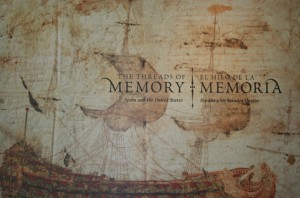 Opening this weekend, The Threads of Memory: Spain and the United States (El Hilo de la Memoria: Espana y los Estados Unidos) weaves the story of Spain’s first 300 years in the Americas. The History Museum marks the U.S. debut of 138 rare and precious documents, maps, illustrations and paintings — but it’s only here until Jan. 9, 2011, so get it on your calendar. (You’ll also enjoy the 12 weeks of lectures, concerts and Chautauqua performances accompanying it; every one of them is free.)
Opening this weekend, The Threads of Memory: Spain and the United States (El Hilo de la Memoria: Espana y los Estados Unidos) weaves the story of Spain’s first 300 years in the Americas. The History Museum marks the U.S. debut of 138 rare and precious documents, maps, illustrations and paintings — but it’s only here until Jan. 9, 2011, so get it on your calendar. (You’ll also enjoy the 12 weeks of lectures, concerts and Chautauqua performances accompanying it; every one of them is free.)
On Thursday, we took a small group of journalists through the still-under-construction exhibit for a sneak peek. And we figured you deserved to ride along.
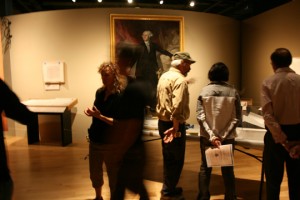 Here, the installation crew buzzes in the part of the gallery where we’ve hung Giuseppe Perovani’s 1796 portrait of George Washington. Many Americans are unaware of the critical role Spain played in helping to win the Revolutionary War. Perovani lived for several years in the United States and, in 1801, with the prestige he had earned, went to Cuba on contract with Archbishop Espejo to help decorate the Cathedral of Havana. He also worked as a teacher there and, afterward, moved back to Mexico, where he became an academic of merit and second director of painting in the Academia de Bellas Artes de San Carlos.
Here, the installation crew buzzes in the part of the gallery where we’ve hung Giuseppe Perovani’s 1796 portrait of George Washington. Many Americans are unaware of the critical role Spain played in helping to win the Revolutionary War. Perovani lived for several years in the United States and, in 1801, with the prestige he had earned, went to Cuba on contract with Archbishop Espejo to help decorate the Cathedral of Havana. He also worked as a teacher there and, afterward, moved back to Mexico, where he became an academic of merit and second director of painting in the Academia de Bellas Artes de San Carlos.
This portrait was likely commissioned by Jose de Jaudenes y Nebot, Spain’s representative in Philadelphia. Jaudenes knew Washington through Thomas Jefferson and had also been consulted on the negotiation of borders.
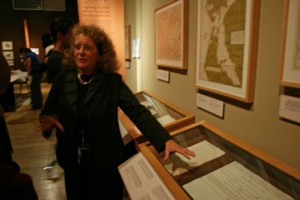 Dr. Frances Levine (left), director of the museum, points to and talks about one of her favorite pieces in the exhibit,a 1786 agreement, hand-written in the Palace of the Governors, between Gov. Juan Bautista de Anza and Comanche Captain General Ecueracapa. The agreement laid out how much help de Anza would receive from the Comanches in an action against the Apaches.
Dr. Frances Levine (left), director of the museum, points to and talks about one of her favorite pieces in the exhibit,a 1786 agreement, hand-written in the Palace of the Governors, between Gov. Juan Bautista de Anza and Comanche Captain General Ecueracapa. The agreement laid out how much help de Anza would receive from the Comanches in an action against the Apaches.
Dr. Levine says that when she first saw the Threads of Memory exhibit in Sevilla, Spain, this particular document not only brought her to tears but convinced her to lobby for its American debut in Santa Fe. The fact that it was written in the same building that she works in every day carried special meaning, along with a deeper knowledge of the conditions that both colonists and Native peoples lived with.
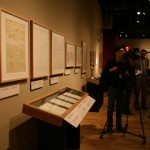 Some of the media members who came to our preview was the EFE News Agency of Spain, which is preparing a story for distribution across that nation this weekend.
Some of the media members who came to our preview was the EFE News Agency of Spain, which is preparing a story for distribution across that nation this weekend.
 Among EF’s interviews was one with Santa Fe Mayor David Coss. The city of Santa Fe, celebrating the 400th anniversary of its founding by Spanish colonists, played a key role in bringing the exhibit to life here.
Among EF’s interviews was one with Santa Fe Mayor David Coss. The city of Santa Fe, celebrating the 400th anniversary of its founding by Spanish colonists, played a key role in bringing the exhibit to life here.
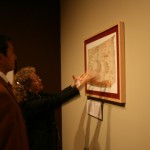 Dr. Levine and Josef Diaz, the museum’s curator of Southwest and Mexican Art and History, examine an illustration of La Belle. The image is the main “brand” of the exhibit; see it above as part of the exhibit title.)
Dr. Levine and Josef Diaz, the museum’s curator of Southwest and Mexican Art and History, examine an illustration of La Belle. The image is the main “brand” of the exhibit; see it above as part of the exhibit title.)
La Belle, a ship, was part of an attempt by France to displace the spreading power of Spain on the lower Mississippi and what is now the American Southwest. The expedition was led by René-Robert Cavelier, Sieur de La Salle, who left France with four ships to claim and colonize the area around the mouth of the Mississippi for France. En route, one ship was lost to pirates, one ran aground, its cargo taken by local natives, and one returned to France. La Salle continued to sail La Belle but missed the Mississippi by some 400 miles, landing on the Gulf Coast, not far from what is now Corpus Christi. The ship was later lost in a storm with about 20 survivors, including La Salle. In 1995, less than 12 feet deep, the remains of the ship were discovered and recovered by the Texas Historical Commission.
At 2 pm on Dec. 19, Eric Ray, a maritime archaeologist with the Texas Historical Commission, will deliver a lecture about La Belle in the History Museum Auditorium.
Finally, meet part of the people responsible for bringing the exhibit here. From left, Falia Gonzalez, Spanish curator of the exhibit from the Archivo General de Indias; 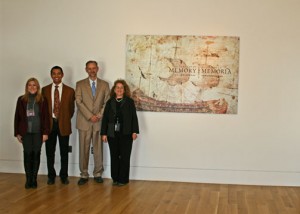 Josef Diaz; Mayor Coss; and Dr. Levine.
Josef Diaz; Mayor Coss; and Dr. Levine.
Please join us for this weekend’s activities — Saturday’s private reception (tickets $100 at the Lensic) and Sunday’s grand opening. Each week through Jan. 9, we’ll have The Threads of Memory Lecture Series — all of it free with museum admission. (Remember: Children 16 and under are always free; Seniors free on Wednesdays; NM residents free on Sundays; and everyone free 5-8 pm Fridays.) Bring your family and enjoy learning more about our rich Spanish roots.
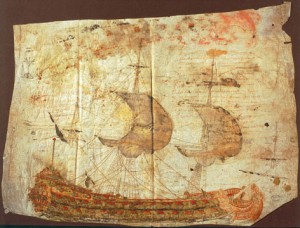

 Opening this weekend, The Threads of Memory: Spain and the United States (El Hilo de la Memoria: Espana y los Estados Unidos) weaves the story of Spain’s first 300 years in the Americas. The History Museum marks the U.S. debut of 138 rare and precious documents, maps, illustrations and paintings — but it’s only here until Jan. 9, 2011, so get it on your calendar. (You’ll also enjoy the 12 weeks of lectures, concerts and Chautauqua performances accompanying it; every one of them is free.)
Opening this weekend, The Threads of Memory: Spain and the United States (El Hilo de la Memoria: Espana y los Estados Unidos) weaves the story of Spain’s first 300 years in the Americas. The History Museum marks the U.S. debut of 138 rare and precious documents, maps, illustrations and paintings — but it’s only here until Jan. 9, 2011, so get it on your calendar. (You’ll also enjoy the 12 weeks of lectures, concerts and Chautauqua performances accompanying it; every one of them is free.) Here, the installation crew buzzes in the part of the gallery where we’ve hung Giuseppe Perovani’s 1796 portrait of George Washington. Many Americans are unaware of the critical role Spain played in helping to win the Revolutionary War. Perovani lived for several years in the United States and, in 1801, with the prestige he had earned, went to Cuba on contract with Archbishop Espejo to help decorate the Cathedral of Havana. He also worked as a teacher there and, afterward, moved back to Mexico, where he became an academic of merit and second director of painting in the Academia de Bellas Artes de San Carlos.
Here, the installation crew buzzes in the part of the gallery where we’ve hung Giuseppe Perovani’s 1796 portrait of George Washington. Many Americans are unaware of the critical role Spain played in helping to win the Revolutionary War. Perovani lived for several years in the United States and, in 1801, with the prestige he had earned, went to Cuba on contract with Archbishop Espejo to help decorate the Cathedral of Havana. He also worked as a teacher there and, afterward, moved back to Mexico, where he became an academic of merit and second director of painting in the Academia de Bellas Artes de San Carlos. Dr. Frances Levine (left), director of the museum, points to and talks about one of her favorite pieces in the exhibit,a 1786 agreement, hand-written in the Palace of the Governors, between
Dr. Frances Levine (left), director of the museum, points to and talks about one of her favorite pieces in the exhibit,a 1786 agreement, hand-written in the Palace of the Governors, between  Some of the media members who came to our preview was the
Some of the media members who came to our preview was the  Among EF’s interviews was one with
Among EF’s interviews was one with  Dr. Levine and Josef Diaz, the museum’s curator of Southwest and Mexican Art and History, examine an illustration of La Belle. The image is the main “brand” of the exhibit; see it above as part of the exhibit title.)
Dr. Levine and Josef Diaz, the museum’s curator of Southwest and Mexican Art and History, examine an illustration of La Belle. The image is the main “brand” of the exhibit; see it above as part of the exhibit title.) Josef Diaz; Mayor Coss; and Dr. Levine.
Josef Diaz; Mayor Coss; and Dr. Levine.